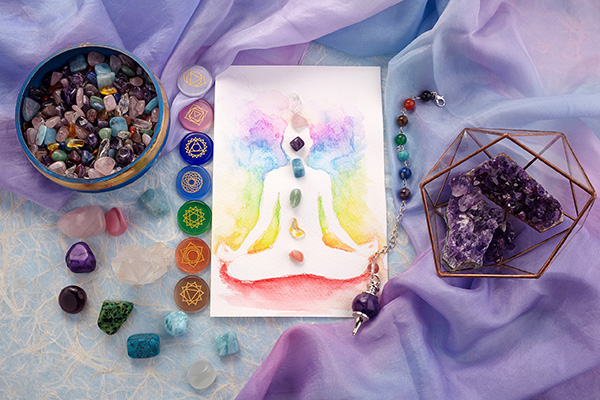How to Manage Lasting Emotions for a Former Romance
 Numerous readings I conduct focus on love and intimate connections, with a significant number centering around previous relationships that still occupy the hearts and minds of some callers.
Numerous readings I conduct focus on love and intimate connections, with a significant number centering around previous relationships that still occupy the hearts and minds of some callers.
For many individuals, there are often persistent, even obsessive, ruminations about an ex-partner, a yearning for another opportunity, or feelings of bitterness and regret about time and energy that now feel wasted. The longer and more profound the relationship, the more scars and emotional injuries tend to exist.
In cases of soulmate or twin flame connections, the aftermath can be particularly harrowing. The relationship has concluded, and the bond has been disrupted in this lifetime. This can lead to immense pain. You’re aware that you invested everything you had. You persevered through years of challenges, or made extraordinary efforts to sustain the relationship’s viability, but the outcome was not as you had envisioned.
If you possess heightened sensitivity and intuitive awareness, you may still be absorbing your former partner’s energy, which can be profoundly painful, unsettling, and disruptive. Unresolved energetic ties can trap you in a repetitive cycle of recreating the same dynamics with that individual, or can leave you stalled, unable to progress peacefully and confidently.
I frequently get asked, “Is it truly over?” or “Does he still care for me?” Naturally, the answer hinges on the specific situation.
On the grief spectrum, losing a significant relationship ranks closely with the death of a loved one. While death is something we are compelled to accept, endings can sometimes result in a very indistinct boundary. It is vital to attain clarity and a proper viewpoint concerning what has transpired and where your future joy resides.
Each time your heart is broken, a doorway slightly opens to a realm brimming with fresh starts and new opportunities ~ Patti Roberts
This is where a session with a trustworthy psychic can prove invaluable. It can provide clarity, solace, and reassurance regarding choices and decisions made throughout the journey.
Emotional Healing & Self-Care
The most crucial action you can take when a relationship concludes is to nurture yourself mentally, physically, and spiritually. Tap into all available healing energies and social support networks. Surround yourself with uplifting, non-critical individuals. Reliable friends, family, and support groups can serve as excellent resources during this period.
Don’t overlook the importance of caring for your health and well-being. A breakup can drastically affect your overall wellness. It assaults your emotional state, and the impact on your physical body will soon follow.
Breakups activate the body’s “fight or flight” response, leading to heightened levels of stress hormones like cortisol. This can trigger symptoms such as trembling, difficulty focusing, and intrusive thoughts. Many individuals also face disrupted sleep patterns and shifts in appetite, swinging between overeating or undereating, frequently turning to comfort foods.
Ongoing stress from a breakup may weaken the immune system, increasing susceptibility to illness. The emotional anguish of a breakup also engages the same brain areas as physical pain, with studies indicating that heartbreak can temporarily enlarge the heart.
Research also indicates that divorced individuals experience higher rates of chronic health issues such as heart disease, cancer, diabetes, and digestive troubles. It can also lead to long-lasting mental health challenges like depression, anxiety, and substance abuse.
The relationship was a significant component of your life. Now that it’s finished, don’t neglect your own needs. This is the moment to affirm your worth and start reconstructing your serenity and happiness with a focus on self-care and self-respect. Think about arranging an energy healing session, a reading from a reliable source, or consulting a support group or therapist. Make it a priority to nurture your well-being every day.
Every woman who ultimately recognized her worth, gathered her bags of pride, and took a flight to freedom, eventually landed in the valley of transformation ~ Shannon L. Alder
Spiritual Practices For Healing
Participating in spiritual self-care practices fosters healing and closure. Some effective methods include
Cord-Cutting: This technique liberates you from the energetic links to your ex’s energy field that still hold you back. Engaging in a cord-cutting meditation, ritual, or healing session where you energetically sever the connection helps you reclaim your freedom and inner calm. It also paves the way for new love interactions in your life. Invoking Archangel Michael’s protection and support, or collaborating with a skilled energy healer, can empower you to release residual attachments so you can advance in your relational life with clarity and emotional stability.
Dreamwork: Numerous people report continuing to dream about their former partner long after the separation. These dreams can feel like an extension of the relationship, unresolved matters, or even spiritual correspondence. If dreams of an ex trouble you, consider setting an intention before you sleep. Ask your higher self or spirit guides for understanding or closure. Journaling about these dreams and their emotional implications can also be a valuable tool for processing unresolved feelings.
Karmic Resolution: Sometimes, a relationship is part of a larger karmic cycle that needs completion. If you sense that a past love lingers in your energy field, it may be worthwhile to explore whether there are lessons that remain unlearned. A past life regression, examining the Akashic Records, or deep meditation can provide insights into whether the relationship represented a recurring pattern from a previous existence. Recognizing these lessons allows you to consciously release cycles that no longer benefit your highest good.
Manifestation: Avoid becoming trapped in pain or lost in anger. Don’t trade your future happiness for the past. Instead, redirect your energy toward manifestation. Build a vision board for the type of love you wish to draw into your life, write affirmations that underscore self-love and self-worth, and trust that the universe is guiding you towards a brighter future. The energy you project will influence what you attract into your life.
Salt Baths: A ritual bath using Epsom, sea, or Himalayan salt can aid in cleansing negative energy remnants from the relationship, fostering a sense of renewal and emotional release. Salt is renowned for its purifying properties, both physically and energetically, making it an ideal method for clearing emotional detritus. As you soak, intend to wash away any sadness, regret, or attachments and allow the water to restore your sense of inner harmony and balance.
Dear John Letter: Composing a heartfelt letter to your ex allows you to articulate unvoiced sentiments — whether love, pain, anger, or gratitude — without the pressures of an actual dialogue. This process provides emotional closure by recognizing the insights gained from the relationship and honoring its effect on your personal development. Once penned, burn or bury the letter as a symbolic act of letting go, signifying your readiness to move on without carrying unresolved feelings. Note: do not send the letter, destroy it.
Candle Ritual: Lighting a candle and focusing on its flame can be a powerful practice for emotional healing and transformation. As you concentrate on the inviting glow, visualize the flame dissolving any lingering attachments or sorrow, making space for new love, peace, and self-acceptance. You can enhance this ritual by silently affirming, “I lovingly release the past and welcome healing into my heart,” allowing the candle’s energy to support your intentions.
Crystal Work: Crystals can serve as valuable allies in the healing process, assisting in restoring emotional equilibrium and fortifying your energy field. Rose quartz is known for fostering self-love and emotional recovery, amethyst promotes spiritual clarity and inner tranquility, while black tourmaline provides protection from residual energetic links to your ex. Holding these stones during meditation or placing them nearby while you sleep can aid your journey towards emotional liberation and rejuvenation.
Embrace yourself, love yourself, and keep progressing forward. If you aspire to soar, you must shed what burdens you ~ Roy T. Bennett
False Hope & Sugar-Coating
When confronting the emotional chaos of a relationship termination, it’s vital to seek guidance from reputable, ethical psychics who prioritize truth and honesty rather than false hope and embellishments.
A breakup often leaves you feeling exposed, seeking clarity, and yearning for reassurance regarding your future. Regrettably, there are unscrupulous practitioners who may exploit your vulnerable emotional state by offering hollow promises or guarantees of a reunion with your ex that may or may not be true, and likely not in your best interest.
Obtaining readings from untrustworthy sources can entrap you in a loop of hope and disappointment, hindering your ability to progress. Some disreputable practitioners even manipulate clients into paying extra for costly curse removals and love spells. This not only depletes their clients’ emotional and financial resources but also obstructs them from fully engaging in their healing journey and pursuing future relationship opportunities.
In contrast, professional psychics deliver readings that emphasize honesty, healing, and personal empowerment, not illusions that may prolong your emotional distress. A trusted psychic guides self-examination and aids you in comprehending the deeper spiritual, emotional, and karmic dynamics underlying the breakup. Rather than focusing on external results — such as whether an ex will return — they will lead you toward personal growth, self-love, and the capacity to make empowered choices as you move forward.
Reputable psychics recognize that healing and clarity stem from bravely confronting reality, not clinging to fantasies. By choosing an ethical reader, you ensure that you receive guidance aligned with your highest intentions, allowing you to heal, let go of attachments, and welcome new opportunities without unnecessary emotional hurdles.
As you navigate a breakup, it’s essential to identify a psychic or medium who upholds integrity, transparency, and kindness — someone who empowers you to embrace the future with clarity and strength, rather than trapping you in the past.
It is always vital to recognize when something has reached its conclusion. Closing circles, shutting doors, completing chapters – it doesn’t matter what terminology we use; what matters is leaving behind those moments in life that are over ~ Paulo Coelho
Don’t Forget Self-Compassion
An essential element often overlooked during a breakup is self-compassion. People tend to concentrate on forgiveness, understanding, and healing, which are vital, yet they frequently forget to offer the same kindness and gentleness to themselves. It’s simple to become wrapped up in spiritual practices of letting go and advancing, but neglecting to recognize and process your own pain can result in extended emotional suffering.
Breakups can be incredibly challenging to process, and it’s crucial to permit yourself to mourn, feel, and heal at your own rhythm. Remember, being spiritually aware also means being compassionate and patient with yourself during times of heartache.
Trust In Divine Timing
No matter what has transpired, have faith that there is a future for you and your heart. Never lose hope for yourself. Trust that the universe operates on divine timing. The pain of loss frequently precedes new beginnings. As you embark on your healing journey, learn the lessons presented to you, and bolster your spiritual and emotional endurance, you are preparing yourself for the love and joy that lies ahead.
True love is meant to uplift, heal, and expand your spirit. If a past relationship no longer corresponds with your highest path, allow it to be a stepping stone, not an anchor. You are deserving of love and belonging, and as you heal, you create space for something more magnificent to enter your life. Never abandon hope for yourself and your future partner.
|
Empathic, intuitive, and psychic since childhood, Angelic Heights (Gail) has learned the significance of using her gifts for the greater good. Until her early 30s, she balanced a marriage and a career in the paralegal sector. Accurate, compassionate, and straightforward, her current focus is entirely on enlightening, uplifting, inspiring, and guiding those in need. Gail believes it is essential to comprehend the energy of the individuals we choose to engage with. Regardless of the underlying issue, whether regarding romance, career, business, or family, the fundamental needs of each client are always clearly conveyed during her readings. She swiftly hones in on key concerns and provides accurate insights and solutions to dilemmas. Experience a reading with her now at PsychicAccess.com |
How to Handle Lingering Feelings for a Lost Love
Love is a multifaceted emotion that can leave a profound mark on our lives. When a relationship concludes, it is entirely natural to feel a spectrum of emotions, such as sadness, anger, and confusion. Occasionally, despite the passage of time, we may still cling to feelings for a lost love. These persistent emotions can prove challenging to manage, yet with the appropriate strategies, it is achievable to move ahead and rediscover happiness. In this article, we will examine some techniques to assist you in addressing lingering feelings for a lost love.
1. Acknowledge your emotions: It is crucial to recognize and embrace your feelings. Allow yourself to mourn the ending of the relationship and understand that experiencing a variety of emotions is perfectly normal. Permit yourself to feel sad, angry, or disappointed. By acknowledging your emotions, you can initiate the healing process.
2. Contemplate the relationship: Spend some time reflecting on the relationship and identifying what drew you to your lost love. It is critical to realize that while there may have been delightful moments together, the relationship ultimately concluded for a reason. Considering the unfavorable aspects of the relationship can help you gain perspective and move on.
3. Disconnect: Keeping in touch with your lost love can hinder your ability to let go of your feelings. Consider severing contact, at least temporarily, to allow yourself the space necessary to heal. This involves unfollowing them on social media and erasing their contact information. It may be tough initially, but it will assist you in emotionally detaching and concentrating on your own well-being.
4. Prioritize self-care: Dedicate time and energy to self-care. Engage in activities that bring you joy and fulfillment. Exercise regularly, eat a balanced diet, and ensure you get adequate rest. Surround yourself with supportive friends and family who can lend a listening ear and offer encouragement. Putting self-care first can help you rebuild your confidence and self-worth.
5. Seek professional assistance if necessary: If you find it difficult to move beyond feelings for your lost love, consider seeking professional help. A therapist or counselor can offer guidance and support as you navigate your emotions. They can aid in clarifying your thoughts, developing coping strategies, and providing a safe environment to express your feelings.
6. Establish new goals and envision your future: Use this period to set new targets and create a vision for what lies ahead. Focus on personal development and explore new hobbies or interests. By redirecting your energy towards positive pursuits, you can cultivate a sense of purpose and anticipation for the future.
7. Be patient: Healing is a gradual process, and it is vital to practice patience with yourself. Understand that moving on from a lost love is a journey that varies from person to person. Grant yourself permission to feel your emotions as they arise and trust that with time, the intensity of your feelings will wane.
Remember, having lingering feelings for a lost love is entirely normal. Nevertheless, it is vital to prioritize your well-being and take proactive steps to heal and move on. By acknowledging your emotions, reflecting on the relationship, engaging in self-care, seeking assistance, and setting new goals, you can gradually release attachments and open yourself up to new opportunities and love in the future. Continue reading
















